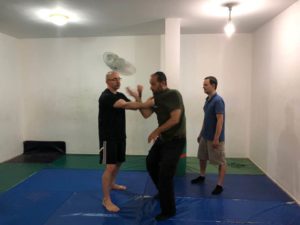We are born grabbing. We find it adorable when we put out our finger and the baby grabs our finger with his little fist. Soon the baby is grabbing everything and putting it into his mouth. This can be dangerous. Too much grabbing is dangerous. As we get older one of the most difficult things is to learn to let go, when the time is right.
The rabbis warn us תָּפַסְתָּ מְרֻבֶּה, לֹא תָּפַסְתָּ
One who has grabbed a lot, has not grabbed anything. (Talmud, various places). We like to grab and the rabbis need to warn us, don’t try and grab too much. And yet we love to grab.
This applies quite literally to Krav Maga. With a knife threat or a shirt grab, or other similar threats, most styles of Krav Maga want to grab. This is actually just an imitation of traditional Japanese jujitsu. With many styles of Japanese and Korean martial arts the grabbing is a key element but with IKI Krav Maga it is not. We shall explain.
People like to grab. There is something in our nature that loves to grab. When I was living in America there was a TV commercial, Don’t grab the Charmin. It was to advertise the softness of bath tissue, so soft that people could not resist grabbing. Humans like to grab. I think primates are the same. And this is a difficult habit to break even when grabbing is counter-productive, as it is with self defense.
Let me repeat, people cannot resist grabbing.
Let us take a self defense scenario; someone grabs your shirt and puts a knife to your throat and pushes you against the wall. Not pleasant at all. Your normal abilities diminish. Your fine motor skills diminish. The problem is that in the training session you still retain those abilities and you imagine that in a real situation you will also possess those abilities. In fact when the stress kicks in, our precision abilities go out. We can’t do the things we trained for. Our training was incorrect.

Now what do most Krav Maga practitioners love to do with this knife threat? You guessed it, GRAB. They love to grab. But I say this is a mistake. Why?
Let’s think logically. The knife is already touching your throat, that means the knife is, so to speak, at the finish line. Not inches away, but touching your skin. Your defense, your hands, is not there, it is a certain distance away. Thus we have a race where one participant is at the start line while the other participant is on the finish line. The referee shouts Start! Who will win?
Of course the man at finish line will win, he is already there. It is the same with the knife threat. The knife is already there, your hands are not there yet. You have almost no chance.
So how are we different?
We are different in that we do not build techniques that rely upon strength, speed, precision movements, fine motor skills, or accuracy.
In the situation we described with the knife threat, we do not try and grab the hand. We do not believe in slight of hand techniques. We are not magicians, but only ordinary humans. What we do is begin with body shifting that removes the body from the knife. A slight shift of the body changes everything, simultaneously we use our wrist to trap or do other movements. We do not attempt to grab the knife. We do not attempt to win a race that is already over.
Of course to actually learn this technique you must come to class, or purchase a DVD, here I only attempt to explain the concept. If you try to grab, you will not succeed. As the rabbis warned us 2,000 years ago, grabbing is dangerous.


Pingback: Language and Krav Maga - Israel Blogger